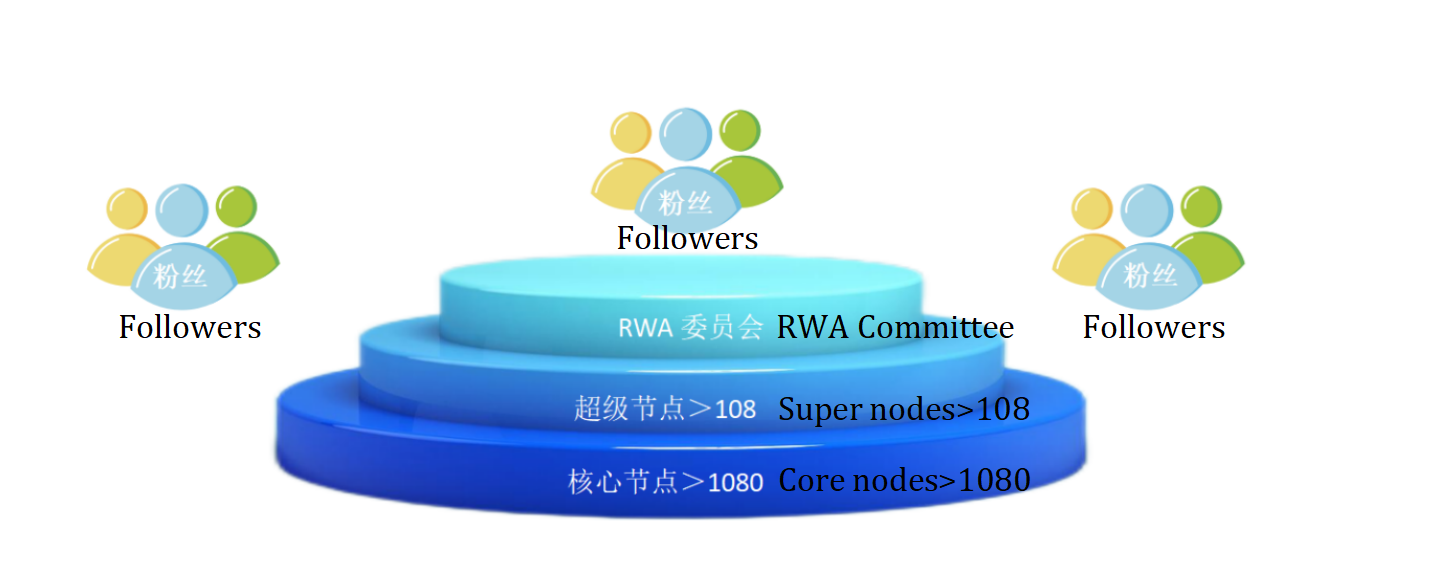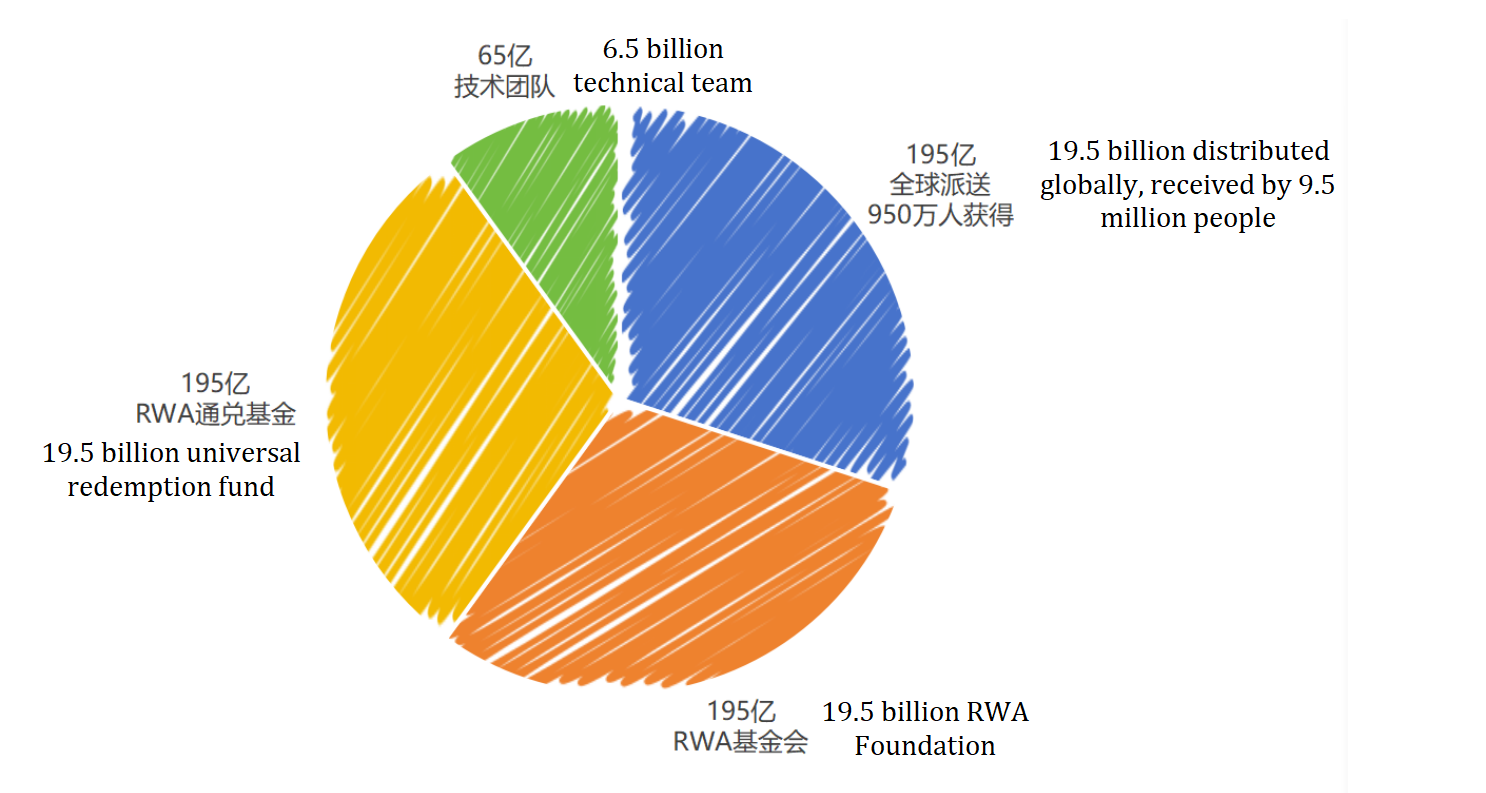RWA: A Digital Currency Connecting Real-World Assets and Their Securitised Products (Application-Oriented)
Abstract: A persistent challenge for real-world assets lies in converting them into financing to enable reproduction, generate profits, and return value to investors—this significantly limits their liquidity. While these assets can be securitised or quasi-securitised to some extent, such as through points, tokens, shares, etc., a practical issue remains: how to truly achieve market-based financing. The RWA public chain will unite the collective efforts of billions globally to form a strong consensus. The native currency of the chain, RWA, will derive credibility from consensus, generate value from credibility, and ultimately establish price and circulation from that value. Supported by a special mechanism, RWA will circulate and be exchanged with securitised and quasi-securitised products through a dedicated valuation framework. This process will continually incorporate various assets and enhance the value of RWA, facilitating the financing of real-world assets. In short, RWA must be grounded in real-world application.
1.Introduction
RWA is a peer-to-peer digital currency embedded within the RWA public chain. It serves a dual purpose—providing liquidity for transactions and acting as fuel (transaction fees) for RWA operations.
The RWA public chain is a decentralised monetary system composed of vast networking nodes. It is tamper-proof, operates independently, and will persist permanently in the internet world.
RWA can be mined through a mechanism combining Proof of Work (PoW) and Proof of Stake (PoS), employing SHA-256 and ECC asymmetric encryption from a cryptographic perspective. Mining RWA consumes CPU time and electricity, and incentives may also come from transaction fees.
RWA was born to enable asset securitisation. Standing for Real World Asset, RWA will mirror a variety of tangible assets such as sand, minerals, real estate, gold, and farms. We are likely to witness a surge in assets becoming securitised, where their shares, financial derivatives, tokens, currencies, and entitlements will be exchangeable with RWA at certain ratios. This will effectively peg digital currency to physical entities, enabling blockchain-powered financial functionality and endowing RWA with immense utility value.
One of the major characteristics of blockchain is its grassroots nature and the generation of value through trust. Its most prominent use is as a currency, followed by various financial attributes. However, substantial evidence shows that these financial utilities remain mostly confined within the blockchain community—primarily used for trading. Although trading reflects value, this is not sufficient. Even with various solutions like smart contracts, the fundamental problem remains unsolved.
RWA is not just a digital currency; it will also be integrated into the trading of securitised or quasi-securitised real-world assets.
2.Currency and Value Generation
Money is a reflection of collective human will. When billions trust a currency, credibility forms, and from that, value emerges. Take BTC (Bitcoin) for example—its value stems from scarcity and fixed issuance. Over time, its mining output decreases. With sustained public confidence, a persistent supply-demand imbalance leads to a stronger currency, thus elevating its price relative to others.
Similarly, RWA will gain strength. The accumulation of public confidence creates consensus.
As this consensus grows over time—and with its convertibility with real-world assets—RWA holds the potential to become even more valuable than BTC.
3.Establishment of RWA's Distributed Credit System
Unlike early digital currencies such as BTC or DOGE, RWA will establish an organised distributed credit consensus system. In the early promotion phase, RWA will set up 108 super core nodes and 1,080 core nodes. A large volume of RWA will be distributed freely by these nodes.
These core and super core nodes not only distribute RWA, but also act as promoters of information, maintain contact with a range of followers, and participate in market value management to some extent.

RWA aims to rapidly build a strong consensus and surpass the initial growth stages once experienced by BTC and DOGE. How will this be achieved? This requires a genius-level blockchain-based consensus design, including the following:
3.1. Mining Pre-Design Rules
Total Supply: 80,000,000,000 (80 billion)
Pre-mined: 65,000,000,000 (65 billion)
Block Time: 1 minute
Block Reward (First 3 years): 5,000 per block
Halving Period: Every 3 years
A fixed issuance plan: 80 billion in total, with 65 billion pre-mined and the remaining 15 billion to be mined over indefinite years, halving every three years, with a block time of one minute.
3.2. Pre-mining Allocation
The total of 65 billion pre-mined RWA will be allocated as follows:
A: 19.5 billion will be directly distributed to approximately 9.5 million people: the first 200,000 users will receive 5,000 each, the next 500,000 will receive 3,000 each, and the remaining recipients will receive 2,000 each.
B: 19.5 billion will form the RWA Exchange Fund, managed by the RWA Committee, and used exclusively for exchanges with real-world assets; most will not enter the secondary market.
C: 19.5 billion will be managed by the RWA Foundation for market value management and ecosystem development, with only a small portion entering the secondary market slowly, and buybacks may occur when necessary.
D: 6.5 billion will be allocated to the technical team for development and maintenance expenses, disbursed gradually over the years.
Note: Only the distributed RWA will directly enter the secondary market. The exchange fund controlled by the RWA Committee is not intended for secondary market flow but for exchanging with real-world assets, positively impacting RWA value.
The Foundation’s 19.5 billion acts as a stabilisation fund, entering the market prudently without causing long-term price declines. Buybacks may occur when necessary to support healthy price growth.
Thus, the initial RWA circulating in the market primarily comes from distributions, favouring consistent price increases and a rising market value.
While blockchain is inherently decentralised, limited centralised operations can improve order and accelerate consensus formation, thereby boosting value.
RWA recognises that blockchain ultimately serves humanity, and modest centralisation is sometimes necessary. All blockchain platforms operate with varying degrees of human oversight, although often lacking transparency, leading to chaos in the field.
3.3. RWA is more than a conventional public chain token
RWA can be exchanged with real-world assets, establishing a mechanism where financial products and RWA interact and circulate infinitely within a blockchain-based liquidity system.

Note: RWA distribution is not a typical airdrop. Each recipient must download the mining wallet—otherwise, they cannot receive RWA. In other words, the mining programme must be activated on a computer, requiring users to take initiative. This is what makes RWA supporters loyal and active, unlike passive airdrop recipients.
Furthermore, only public chain tokens can achieve true decentralised issuance and widespread consensus. Only tokens like RWA can support unlimited transfers within their ecosystem without relying on external chains or consuming external gas fees. RWA is self-sustaining—each transfer fee is recycled via mining. As consensus grows, so does value. When RWA becomes exchangeable with real-world financial assets, its practical use and intrinsic value will also increase infinitely.
4.Exchange Mechanism:
Blockchain is not omnipotent, nor are public chain tokens or smart contracts. Integrating blockchain currency with real-world assets cannot rely solely on technical means—it requires human involvement and auxiliary tools. RWA's integration with real assets is a complex economic activity, not to be taken lightly. Each step—from asset verification, debt assessment, securitisation, fund application, and profit distribution—must be carefully planned and executed.
First, the authenticity of the assets must be confirmed — are there any debts? What is the actual value? This is the first question that needs to be asked. Second, what method will be used to issue securitized or quasi-securitized products? Third, how can we ensure that the funds raised will be used appropriately? Fourth, how will the returns generated from post-financing investments be managed? All of these tasks must be carried out by people — and they are serious matters. Business operations cannot be handled carelessly or arbitrarily.
To oversee this, a democratically elected 'RWA Committee' composed of super and core nodes will be established, with departments such as audit, finance, and market value management ensuring trust and order.
The goal is genuine community governance—fair, transparent, and capable of converting, linking, and growing value. This model not only facilitates circulation but also creates new wealth.
This mechanism acts as both a converter and an incubator, involving stages such as application, verification, evaluation, securitisation, exchange, circulation, and staking (especially using profits to repurchase RWA).
Example: A mining enterprise seeks financing. Step 1: Prove its authenticity and reliability—the RWA Committee will be involved throughout. Step 2: Determine the financing plan. Step 3: Issue securitised or quasi-securitised products to the market, accepting only RWA. This issuance process itself increases RWA's value. Requirement: a portion of the received RWA (e.g., 20%) must be frozen, while the rest may be sold to obtain cash. Frozen RWA must be released through future profits, promoting stability and value growth.
When profits are realised, the frozen RWA can be gradually released, and part of the income will be used to repurchase RWA, thus further increasing its value.
In other words, each exchange event will strengthen RWA's value in two ways: (1) enhancing its liquidity and use, and (2) linking it with real-world assets and returns.
Caution: Any misstep in this process could cause serious financial losses. Without the oversight of the RWA Committee, such economic activities would be unimaginable.
Conclusion: RWA is decentralised, but economic operations are semi-centralised. A decentralised monetary system combined with limited centralised oversight creates a dynamic positive-feedback system that integrates real-world assets with a digital currency ecosystem.
This structure will continually expand RWA’s consensus network.
5.RWA Value Preservation and Growth Strategy
Normally, a fixed-supply public chain with an active ecosystem sees increasing value over time. This is well-supported by historical precedent.
However, this alone is not sufficient.
First, The utility of a currency increases with usage and circulation. That is the purpose of the exchange mechanism—to promote ongoing use and liquidity through RWA. Crucially, RWA is not confined to the blockchain realm. It is open and inclusive—embracing the world.
Second, in every exchange scenario, asset holders must use part of their profits to buy RWA and lock it as reserve capital for at least three years, thereby injecting real-world funds into RWA’s value system.
Third, RWA will also be integrated into blockchain games, e-commerce platforms, international trade, and other sectors.
Additional cooperation and platforms related to RWA will continue to promote its prosperity.
6.RWA Committee Overview
Leveraging decentralisation and blockchain foundations, RWA aims to solve traditional financial problems by building ecosystem applications—which require broad participation.
Human engagement is at the core of all RWA activities. When the blockchain economy merges with real-world assets, only human involvement can ensure practicality and success.
Ecosystem creation requires massive human input and grounded, accountable teams.
The RWA Committee represents the global RWA community.
Members are selected from excellent core and super nodes, initially numbering 5 to 9, with flexible expansion. They are responsible for facilitating exchanges with real-world assets, ensuring asset value growth and circulation, and participating in market value oversight. Details will be published on the official website.
Note: The RWA Committee’s duties will evolve over time. Though RWA was initiated by the community, its upkeep requires more than just technical maintenance—it calls for active civil participation.
7.Future Outlook
The RWA Committee will actively collaborate with governments, enterprises, academic institutions, and civil groups.
Once the user base reaches critical mass, RWA will be listed on major global exchanges, fostering a vibrant secondary market.
In time, RWA will launch its metaverse platform.
RWA will also integrate with third-generation Web3-based smart chains, expected by around 2026—details will be shared on the website.
More ecosystem applications will continue to emerge…
8.Technical details of the RWA public chain will be published on international open-source platforms such as GitHub.